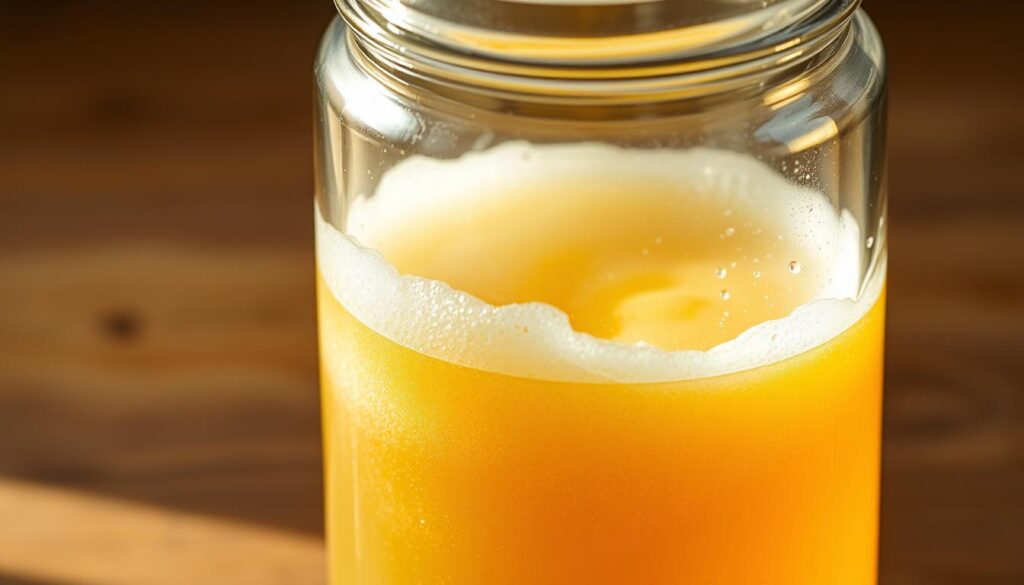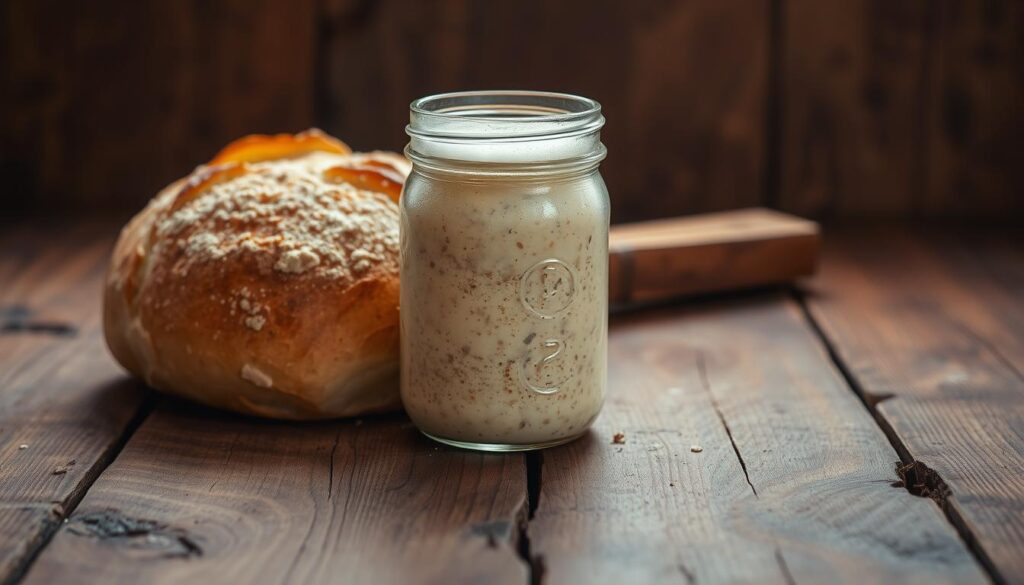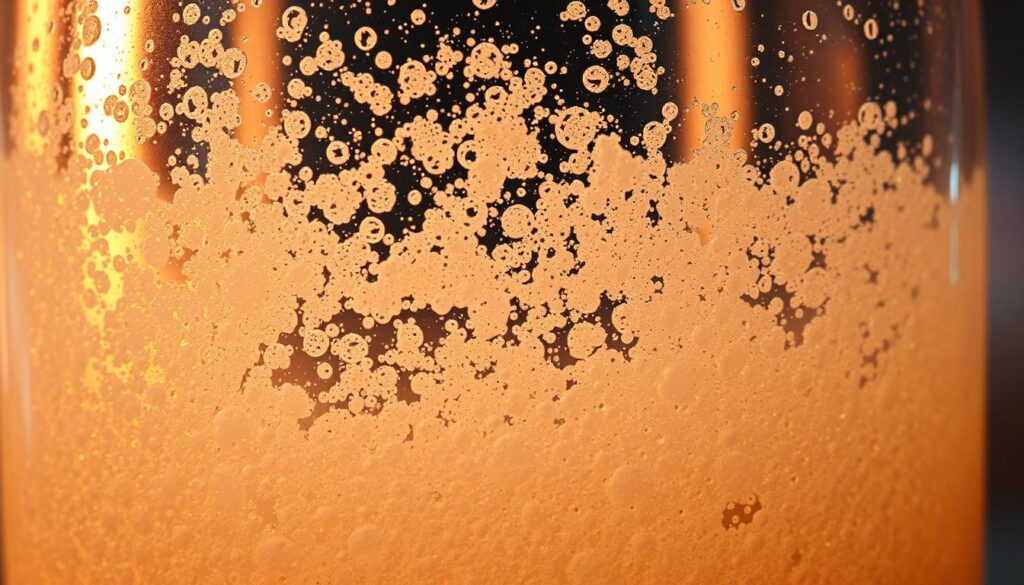Once upon a time, breweries and bakeries coexisted harmoniously, sharing a symbiotic relationship that benefited both industries. The by-product of the fermenting process was a foam that formed on top of the fermenting liquor, known as barm. This malty foam was rich in natural yeast, making it an ideal ingredient for bakers to leaven their dough.
We will explore the fascinating world of ale barm, a traditional leavening agent used for centuries before the advent of commercial yeast. By understanding the historical connection between brewing and baking, we can appreciate the value of this natural ingredient in creating distinctive, flavorful bread with complex characteristics.
Key Takeaways
- Ale barm is a natural byproduct of beer fermentation that contains wild yeasts.
- It has been used historically as a leavening agent in bread baking.
- The use of ale barm represents a connection between traditional brewing and baking practices.
- Baking with ale barm can create bread with unique flavors and characteristics.
- Understanding the differences between ale barm and commercial yeast can enhance your baking skills.
- Ale barm is experiencing a resurgence among modern bakers seeking traditional methods.
Understanding Ale Barm
Ale barm, a byproduct of ale fermentation, was once the primary leavening agent used in bread making across Europe. This practice, deeply rooted in history, connected breweries and bakeries in a symbiotic relationship.
Definition and Origin
Ale barm is essentially the froth or foam that forms on top of fermenting ale, rich in wild yeast and bacteria. Historically, it was used as a leavening agent in bread making, providing the necessary fermentation for dough to rise. The use of ale barm in baking dates back to medieval times, when the distinction between breweries and bakeries was not as pronounced as it is today.

Historical Significance in Baking
The historical significance of ale barm in bread making cannot be overstated. It was the primary leavening agent throughout medieval Europe, creating a strong link between brewers and bakers. The use of barm resulted in distinctive regional bread varieties that reflected local brewing traditions and available ingredients.
- We explore how ale barm was used as a leavening agent, creating complex flavors and reliable rising properties in bread.
- The transition from barm to commercial yeast changed baking practices, affecting the taste and nutritional profile of everyday bread over time.
- Historical recipes frequently mentioned barm as an essential ingredient, highlighting its central importance in pre-industrial food production, somewhat similar to how sourdough is used today.
- The connection between ale barm and ale production underscores the historical intertwining of brewing and baking practices.
By understanding ale barm and its role in history, we can appreciate the evolution of yeast in baking and its impact on modern bread making.
The Historical Connection Between Breweries and Bakeries
The historical tie between breweries and bakeries is a fascinating tale of symbiosis and innovation. For centuries, bakeries relied on breweries for yeast, a crucial ingredient in bread making. This relationship was not just about sharing resources; it was a deep-seated connection that influenced the development of both industries.

The Symbiotic Relationship
The relationship between breweries and bakeries was symbiotic, with each benefiting from the other’s byproducts. Breweries produced yeast as a byproduct of beer fermentation, which was then used by bakeries to leaven their bread. This mutually beneficial arrangement was essential before the advent of commercial yeast. The use of ale barm, a type of yeast-rich foam skimmed from fermenting beer, was common in baking. This practice not only affected the flavor of the bread but also tied the two crafts together in a way that was both practical and traditional.
How Commercial Yeast Changed Bread Making
By the late 19th century, the development of commercial yeast revolutionized bread making. Yeast specifically cultivated for bread making became commercially available, first in block form and later in dry, granulated form. This change allowed bakers to work independently from brewers for the first time in centuries, fundamentally altering both industries. The standardization of yeast led to more uniform bread products but also resulted in the loss of regional bread varieties and traditional baking knowledge. As we explore this transition, we notice how it transformed bread from a slow-fermented, artisanal product to a mass-produced commodity. Some key changes include:
- The development of commercial yeast provided a consistent, readily available leavening agent, revolutionizing bread making.
- The standardization of yeast led to more uniform bread products but also resulted in the loss of regional bread varieties.
- Commercial yeast allowed bakers to work independently from brewers, changing both industries.
In conclusion, the historical connection between breweries and bakeries is a testament to the innovative and symbiotic nature of these crafts. As we move forward in time, understanding this history helps us appreciate the evolution of bread making and the role of yeast in this process. Today, many bakers are rediscovering traditional methods, including the use of ale barm, as a way to bring back the unique flavors and characteristics of artisanal bread.
Ale Barm vs. Modern Baking Yeasts
Understanding the differences between ale barm and modern baking yeasts is crucial for bakers looking to choose the right leavening agent for their bread. The choice between these two leavening agents affects not just the baking process, but also the final product’s characteristics, including flavor, texture, and nutritional content.
Nutritional and Flavor Differences
Ale barm, derived from the fermentation process of beer, brings a unique set of nutritional and flavor profiles to bread making. It takes advantage of both sprouted and fermented grains, which are not only easier to digest but also rich in various health-imbuing properties. The mixed culture of microorganisms in ale barm contributes to a complex flavor profile, often described as having a mild sourdough-like effect. In contrast, modern commercial yeast provides a more predictable and consistent rise but lacks the depth of flavor and nutritional enhancements associated with ale barm.

Fermentation Characteristics
The fermentation characteristics of ale barm and commercial yeast differ significantly. Ale barm typically produces a slower, more gradual fermentation, requiring longer proofing time. This slower process develops more complex flavors and affects the dough structure, often creating a more open, irregular crumb with a distinctive texture. The gas production patterns and the byproducts of yeast fermentation in ale barm not only contribute to the flavor but also naturally extend the shelf life of the finished bread, made with flour and water.
In summary, the choice between ale barm and modern baking yeasts depends on the baker’s priorities regarding flavor, texture, and nutritional content, as well as the desired characteristics of the final product.
How to Obtain Ale Barm
Ale barm, a valuable resource for bakers, can be sourced from various places, including local breweries and home brewing setups. Understanding the different sourcing methods is crucial for maintaining a consistent supply of this ingredient.
Sourcing from Local Breweries
Local breweries are a primary source for obtaining ale barm. Many breweries are willing to share their barm with bakers, especially if they have a surplus. It’s essential to establish a relationship with the brewery staff and inquire about their barm disposal policies. Some breweries might require you to pick it up promptly, while others may store it for you. Always handle the barm hygienically to avoid contamination.
Collecting Barm from Home Brewing
For those involved in home brewing, collecting barm from your own brewing process can be a convenient and cost-effective method. After fermentation, the barm can be skimmed off and used immediately or stored for later use. Ensure that your brewing equipment is sanitized to prevent contamination of the barm. Regularly inspecting your barm for signs of spoilage is also crucial.
Storing and Maintaining Your Barm
If you cannot use all the ale barm right away, you can store it in the fridge for a couple of weeks. It’s crucial to drain off any alcohol that forms on top, as it can kill off the yeast. For barm stored for more than a week, use the sponge method to reactivate the yeast by feeding it fresh flour and water. Here are some key storage tips:
- Store barm in a clean, airtight container to prevent contamination.
- Regularly “feed” your stored barm with fresh flour and water to maintain yeast activity.
- Monitor your barm for signs of healthy activity, such as bubbles or a slightly sour smell.
Creating a Barm Starter for Baking
The process of creating a barm starter is both an art and a science, requiring patience and attention to detail. To start, you’ll need to mix ale barm with flour and water to create a sponge that will eventually become your starter.
Basic Barm Starter Recipe
To create your barm starter, mix 1/2 cup of ale barm (beer mash), 1/4 cup of flour, and 1/2 cup of water in a large bowl the night before you plan to bake. Cover the mixture with a cotton or linen towel and let it sit on the counter overnight. This mixture, known as a sponge, is the beginning of your barm starter.
The next morning, your sponge should be frothy and have a yeasty aroma, indicating that the fermentation process has begun. At this point, you can start using it in your bread recipe or continue to feed it to make a more robust starter.
| Ingredient | Quantity | Purpose |
|---|---|---|
| Ale Barm | 1/2 cup | Provides yeast and bacteria for fermentation |
| Flour | 1/4 cup | Nourishes the yeast and bacteria |
| Water | 1/2 cup | Hydrates the mixture, facilitating fermentation |
Signs of a Healthy, Active Starter
A healthy barm starter is characterized by consistent bubbling, a predictable rise and fall pattern, and a pleasant, yeasty aroma. The texture should be thick and creamy, similar to pancake batter. If your starter is too dry or too wet, it may need adjustments in feeding.
Visual indicators of a healthy starter include bubbles on the surface and throughout the starter, indicating active fermentation. The starter should also double in size within a few hours after feeding, showing that the yeast is actively producing CO2.
By monitoring these signs and adjusting your care routine accordingly, you can maintain a healthy, active barm starter that’s ready to use in your bread recipes.
Traditional Ale Barm Bread Recipe
We’re diving into the world of traditional bread making with ale barm, a yeast-rich byproduct of beer brewing. This ancient technique not only reduces waste but also creates a bread that’s both flavorful and rich in history.
Ingredients and Equipment
To make a delicious ale barm bread, you’ll need the following ingredients: 1 cup of ale barm (beer mash), 100ml of water, 1 tsp of uber-barm (optional), all-purpose or bread flour, 1 tsp of sea salt, 1 Tbs of honey, and olive oil or melted butter for finishing. The equipment required includes a mixing bowl, measuring cups, a wooden spoon or dough whisk, and a baking vessel or bread stone.
The Sponge Method
The sponge method involves creating a pre-ferment by mixing the ale barm with flour and water, allowing it to ferment before adding it to the rest of the dough ingredients. This method enhances the flavor and texture of the bread. To start, combine 1 cup of ale barm with an equal amount of flour and enough water to create a thick batter. Let it rest for several hours or overnight until it becomes bubbly and active. Then, mix this pre-ferment with the remaining flour, salt, and honey to form the dough.
Using the sponge method, you can expect a more complex flavor profile due to the longer fermentation time. This method is ideal for those who want to enhance the yeast activity in their bread, resulting in a lighter, airier crumb.
The Direct Method
For those with very fresh, active ale barm, the direct method is a simpler alternative. This involves mixing all the ingredients together in one step, without creating a pre-ferment. When using this method, it’s crucial to protect the yeast from direct contact with salt by adding the salt to the flour before mixing in the ale barm and other wet ingredients.
The direct method results in a bread that is still rich in flavor but with a slightly different character compared to the sponge method. The dough will be more delicate, requiring gentle handling to avoid over-working. The hydration level of the dough may need adjustment due to the nature of ale barm, and the fermentation time will be longer than with commercial yeast.
By following either the sponge or direct method, you can create a delicious bread that showcases the unique qualities of ale barm. Experimenting with both techniques will help you understand the nuances of working with this traditional ingredient.
Step-by-Step Baking Process
Now that we’ve explored the history and preparation of ale barm, let’s dive into the step-by-step process of baking with it. Baking bread with ale barm is a multi-faceted process that involves careful attention to detail at every stage, from mixing to storage.
Mixing and Kneading
The first step in baking with ale barm is mixing and kneading the dough. Combine your ale barm starter with flour, water, and any other ingredients your recipe calls for in a large mixing bowl. The mixture should form a shaggy dough. Kneading is crucial as it develops the gluten in the dough, giving the bread its structure. You can knead by hand or use a stand mixer with a dough hook attachment. The goal is to achieve a smooth, elastic dough.
Fermentation and Proofing
After kneading, the dough needs to undergo fermentation and proofing. Place the dough in a lightly oiled bowl, cover it with a damp cloth, and let it ferment in a warm, draft-free place. The fermentation process can take several hours, depending on the temperature and the activity of your ale barm starter. Once the dough has risen, gently deflate it and shape it into your desired form. Let it proof again until it has doubled in size.
Baking Techniques for Barm Bread
Baking barm bread requires a bit more care than bread made with commercial yeast due to its potentially higher moisture content. Preheat your oven to the appropriate temperature, and gently place your proofed dough onto a baking stone or baking sheet. Bake until the bread is golden brown and sounds hollow when tapped on the bottom. The baking time will vary depending on the size and shape of your loaves.
Cooling and Storage
Cooling is a critical step in the baking process, especially for barm bread, which tends to sweat more than regular bread. It’s essential to cool the bread on a wire rack to allow air to circulate around it. As we’ve emphasized, please refrain from putting the bread in plastic until it’s completely cool; instead, use a cotton or linen cloth, or if necessary, a paper bag. Proper cooling prevents sogginess and preserves the bread’s texture. For longer storage, consider using a bread box or storing it in the fridge to extend its freshness.
Troubleshooting Common Issues with Barm Baking
The art of barm baking is nuanced, and troubleshooting is an essential skill for achieving the perfect loaf. As we explore the common issues that arise during barm baking, we can better understand how to address them effectively.
Slow or No Fermentation
Slow or no fermentation is a common issue in barm baking, often caused by factors such as inadequate yeast activity, incorrect temperatures, or insufficient nutrients. To address this, we can check the viability of our barm by observing its activity and adjusting its feeding schedule. Ensuring that the dough is at the right temperature and providing adequate time for fermentation can also help.
Flavor Problems
Flavor issues in barm bread can arise from various factors, including the type of flour used, the barm’s maturity, and the fermentation time. To troubleshoot flavor problems, we can experiment with different flour types and adjust the fermentation time to achieve the desired flavor profile. Additionally, maintaining a healthy barm through regular feeding is crucial.
Texture Issues
Texture problems, such as dense or gummy crumb, can be addressed by adjusting the hydration levels in the dough and ensuring proper kneading techniques. The table below summarizes common texture issues and potential solutions.
| Issue | Cause | Solution |
|---|---|---|
| Dense Crumb | Insufficient hydration or overmixing | Adjust hydration levels and kneading technique |
| Gummy Crumb | Underbaked or excessive moisture | Ensure proper baking time and temperature |
| Excessive Holes | Over-fermentation or uneven dough | Monitor fermentation time and dough handling |
By understanding and addressing these common issues, we can improve our barm baking skills and produce high-quality bread. Regularly maintaining our barm and adjusting our techniques based on the specific characteristics of our ingredients and environment are key to success.
Rediscovering Traditional Baking Methods
With growing interest in food heritage, traditional leavening methods like ale barm are gaining popularity. Artisan bakers rediscover unique flavors and textures, differentiating their products.
By experimenting with yeast, bakers create artisanal breads. Collaboration between breweries and bakeries enhances this method, preserving our food culture. This revival includes traditional techniques, such as using by-products from wine making, to create distinctive breads, thus keeping our culinary heritage alive through innovative baking practices with yeast.


